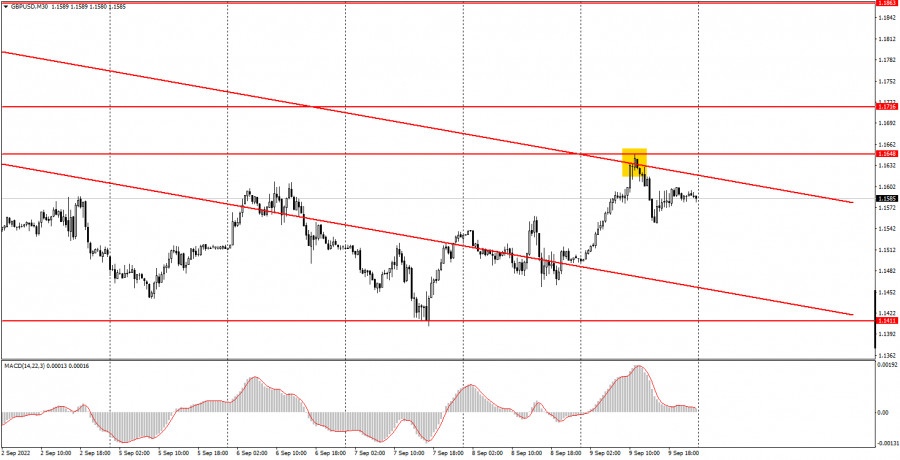

The GBP/USD pair rose to the resistance level of 1.1648 on Friday, rebounded from it, and at the same time rebounded from the upper border of the descending channel, which is still relevant. Thus, the pound already has every reason to resume the downtrend back to the level of 1.1411. We have said before that we do not believe in the market's inability to push the pair below its 37-year low. If this level has been worked out, then, most likely, the quotes will continue to fall. In any case, before the price settles above the channel, we cannot count on a strong growth of the British currency. Despite the fact that the downward trend has been going on for a very long time and the pound has thoroughly fallen in price within its framework, we still believe that it has not yet been completed, but, of course, it will end sooner or later. There were no important events or reports in either the UK or the US on Friday, so there was nothing for traders to react to. Recently, the pound and the euro have been moving very similarly again, although, for example, the European Central Bank meeting took place on Thursday, which had nothing to do with the pound.
5M chart of the GBP/USD pair
The trading picture on the 5-minute timeframe was very complex on Friday. We should start with the fact that three levels at the end of the day were recognized as irrelevant and removed from the charts - 1.1560, 1.1601 and 1.1620. Instead, levels 1.1550 and 1.1608 were formed. The movement in the European trading session was very good, trendy, and it was rather weak in the US session, but still not flat. The first trading signal was formed near the level of 1.1601. However, a long position should have been opened when the level of 1.1620 was overcome, but even in this case, there was a rather small distance to the nearest target. It was possible to earn 5-10 points on this deal. The bounce off the 1.1648 level was a really good signal, after its formation the pound went down 85 points and only stopped near the 1.1560 level, from which it bounced very inaccurately. It turned out to earn at least 65 points. The buy signal could be worked out but in any case, it was not unprofitable, so novice traders could add a couple more tens of points of profit. The day ended in good profit for the newbies.
How to trade on Monday:The pound/dollar pair continues to follow a downward trend on the 30-minute TF. The price has already fallen to its lowest for 37 years, so in the near future we can count on its overcoming. The descending channel also remains relevant on the 30-minute TF, and the price continues to settle inside it, so there are no technical grounds for the pound's succeeding growth yet. On the 5-minute TF tomorrow, it is recommended to trade at the levels of 1.1411, 1.1443, 1.1498, 1.1550, 1.1608, 1.1648, 1.1716. When the price passes after opening a deal in the right direction for 20 points, Stop Loss should be set to breakeven. The release of reports on GDP and industrial production is scheduled for Monday in the UK. These reports may have a certain impact on the movement of the pound/dollar pair, but it is unlikely to be strong. The GDP report is not quarterly, which is the most important.
Basic rules of the trading system:1) The signal strength is calculated by the time it took to form the signal (bounce or overcome the level). The less time it took, the stronger the signal.
2) If two or more deals were opened near a certain level based on false signals (which did not trigger Take Profit or the nearest target level), then all subsequent signals from this level should be ignored.
3) In a flat, any pair can form a lot of false signals or not form them at all. But in any case, at the first signs of a flat, it is better to stop trading.
4) Trade deals are opened in the time period between the beginning of the European session and until the middle of the American one, when all deals must be closed manually.
5) On the 30-minute TF, using signals from the MACD indicator, you can trade only if there is good volatility and a trend, which is confirmed by a trend line or a trend channel.
6) If two levels are located too close to each other (from 5 to 15 points), then they should be considered as an area of support or resistance.
On the chart:Support and Resistance Levels are the Levels that serve as targets when buying or selling the pair. You can place Take Profit near these levels.
Red lines are the channels or trend lines that display the current trend and show in which direction it is better to trade now.
The MACD indicator (14,22,3) consists of a histogram and a signal line. When they cross, this is a signal to enter the market. It is recommended to use this indicator in combination with trend lines (channels and trend lines).
Important speeches and reports (always contained in the news calendar) can greatly influence the movement of a currency pair. Therefore, during their exit, it is recommended to trade as carefully as possible or exit the market in order to avoid a sharp price reversal against the previous movement.
Beginners on Forex should remember that not every single trade has to be profitable. The development of a clear strategy and money management are the key to success in trading over a long period of time.